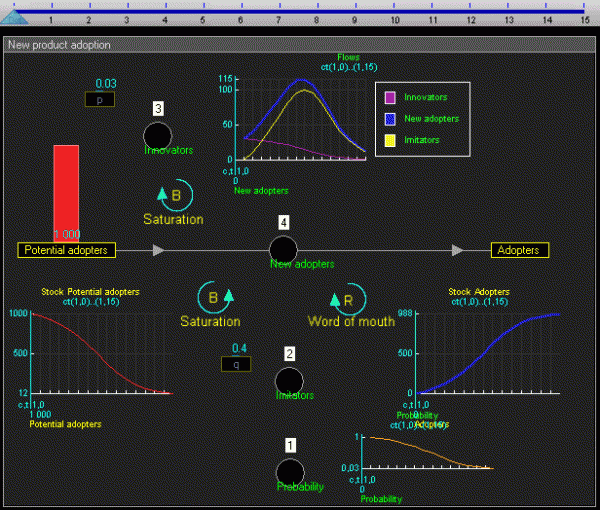
Dynamic stock and flow diagram of New product adoption model [1]
On July 14, 1918, pioneering American computer engineer and systems scientist Jay Wright Forrester was born. Forrester is known as the founder of system dynamics, which deals with the simulation of interactions between objects in dynamic systems. He also he supervised the building of the Whirlwind computer at the Massachusetts Institute of Technology, for which he invented the random-access magnetic core memory, the information-storage device employed in most digital computers.
“In concept a feedback system is a closed system. Its dynamic behavior arises within its internal structure. Any action which is essential to the behavior of the mode being investigated must be included inside the system boundary.”
— Forrester JW. 1968b. Principles of Systems.
Massachusetts Institute of Technology
Forrester was born on a farm near Anselmo, Nebraska, to Ethel Pearl Wright Forrester and Marmaduke (Duke) Montrose Forrester, where his early interest in electricity was spurred, perhaps, by the fact that the ranch had none. While in high school, he built a wind-driven, 12-volt electrical system using old car parts — it gave the ranch its first electric power. Forrester received his Bachelor of Science in Electrical Engineering in 1939 from the University of Nebraska–Lincoln, was inducted in 1949 into Eta Kappa Nu (HKN) the Electrical & Computer Engineering Honor Society, and went on to graduate school at the Massachusetts Institute of Technology, where he would spend his entire career.
The Whirlwind Project
During the 1940s and early 50s, he did research in electrical and computer engineering, heading the Whirlwind project, perfecting magnetic-core memory, and developing the “multi-coordinate digital information storage device” (coincident-current system), the forerunner of today’s RAM. Whirlwind I was a Cold War-era vacuum tube computer developed by the MIT Servomechanisms Laboratory for the U.S. Navy. It was amongst the first digital electronic computers that operated in real-time for output, and the first that was not simply an electronic replacement of older mechanical systems. Moreover, it was one of the first computers to calculate in parallel (rather than serial), and was the first to use magnetic core memory.
Bit-Parallel Computing
Most computers of the era operated in bit-serial mode, using single-bit arithmetic and feeding in large words, often 48 or 60 bits in size, one bit at a time. This was simply not fast enough, so Whirlwind included sixteen such math units, operating on a complete 16-bit word every cycle in bit-parallel mode. Ignoring memory speed, Whirlwind was essentially sixteen times as fast as other machines. Today almost all CPUs do arithmetic in “bit-parallel” mode. Its development led directly to the Whirlwind II design used as the basis for the United States Air Force SAGE air defense system, and indirectly to almost all business computers and minicomputers in the 1960s.[4] Whirlwind construction started in 1948, an effort that employed 175 people including 70 engineers and technicians. Whirlwind took three years to build and first went online on April 20, 1951. The project’s budget was approximately $1 million a year, which was vastly higher than the development costs of most other computers of the era.
Real Time Aircraft Tracking
The MIT Whirlwind computer required a fast memory system for real-time aircraft tracking use. At first, Williams tubes — a storage system based on cathode ray tubes — were used, but these devices were always temperamental and unreliable. Several researchers in the late 1940s conceived the idea of using magnetic cores for computer memory, but Jay Forrester received the principal patent for his invention of the coincident core memory that enabled the 3D storage of information. The first core memory of 32 x 32 x 16 bits was installed on Whirlwind in the summer of 1953. Magnetic-Core Storage has two big advantages: greater reliability with a consequent reduction in maintenance time devoted to storage and most importantly shorter access time thus increasing the speed of computer operation. Magnetic-core memory became the predominant form of random-access computer memory for 20 years between about 1955 and 1975.
The Forrester Effect
Forrester is also believed to have created the first animation in the history of computer graphics, a “jumping ball” on an oscilloscope. In 1956, Forrester moved to the MIT Sloan School of Management, where he was Germeshausen Professor Emeritus and Senior Lecturer. In 1961, arising from a project with General Electric, he wrote about the expanding effects down the supply chains due to fluctuations in demand, thenceforth known as the “Forrester effect” or bullwhip effect. The effect refers to increasing swings in inventory in response to shifts in customer demand as one moves further up the supply chain. The bullwhip effect was named for the way the amplitude of a whip increases down its length. The further from the originating signal, the greater the distortion of the wave pattern. In a similar manner, forecast accuracy decreases as one moves upstream along the supply chain. For example, many consumer goods have fairly consistent consumption at retail but this signal becomes more chaotic and unpredictable as the focus moves away from consumer purchasing behavior. The bullwhip effect first was described in Forrester’s 1961 book “Industrial Dynamics“, in which Forrester also introduced his main subject of research: system dynamics. System dynamics deals with the simulation of interactions between objects in dynamic systems. In Industrial Dynamics Forrester applied system dynamics to analyze industrial business cycles. Several years later, interactions with former Boston Mayor John F. Collins led Forrester to write Urban Dynamics, which sparked an ongoing debate on the feasibility of modeling broader social problems.
The Urban Dynamics Model
The urban dynamics model attracted the attention of urban planners around the world, eventually leading Forrester to meet a founder of the Club of Rome. Among other things, Forrester’s methods were the basis of the book The Limits to Growth, published in 1972. He later met with the Club of Rome to discuss issues surrounding global sustainability; the book World Dynamics followed. World Dynamics took on modeling the complex interactions of the world economy, population and ecology, which was controversial. It was the start of the field of global modeling. Forrester continued working in applications of system dynamics and promoting its use in education.
Later Life
In 1982, he received the IEEE Computer Pioneer Award. In 1995, he was made a Fellow of the Computer History Museum “for his perfecting of core memory technology into a practical computer memory device; for fundamental contributions to early computer systems design and development”. Jay Wright Forrester died on November 16, 2016, in Concord Massetschussetts, at age 98.
Applications of System Dynamics – Jay W. Forrester [8]
References and Further Reading:
- [1] John Sterman (2001) Systems dynamics modeling: tools for learning in a complex world, California management review, Vol 43 no 1, Summer 2001.
- [2] Zack Church, Professor Emeritus Jay Forrester, digital computing and system dynamics pioneer, dies at 98, at MIT News, Nov 19,2016.
- [3] David C. Lane, John D. Sterman: Jay Wright Forrester, in Profiles in Operations Research: Pioneers and Innovators, Springer, 2011, pp. 363-386.
- [4] J.C.R. Licklider and Interactive Computing, SciHi Blog
- [5] Jay Wright Forrester at Wikidata
- [6] Jay Wright Forrester at the Mathematics Genealogy Project
- [7] “The many careers of Jay Forrester,” MIT Technology Review, June 23, 2015
- [8] Applications of System Dynamics – Jay W. Forrester, 2015, James R. Killian, Jr. Lecture Series @ youtube
- [9] Katie Hafner, “Jay W. Forrester Dies at 98; a Pioneer in Computer Models”, The New York Times, November 17, 2016.
- [10] Timeline of Computer Hardware Engineers, according to DBpedia and Wikidata





